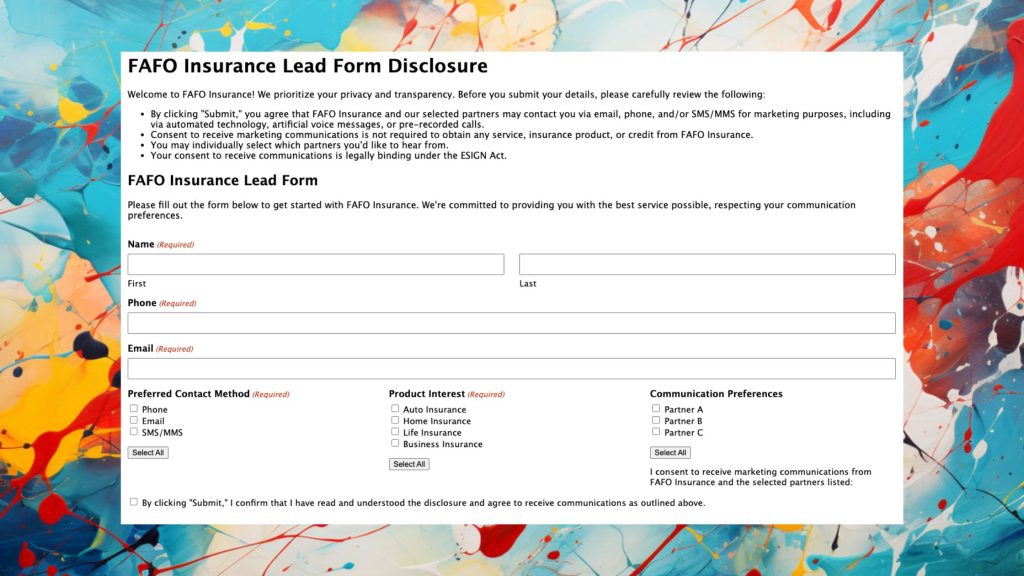Before we get started I wanted to let you know, the original source of this is from one of my favorite sites TCPAWorld. This is sourced from the Troutman Amin Fifteen. They’re one of my favorite sources for TCPA news. I decided to write about this issue because I know sometimes we all struggle with implementing things that don’t look like what we normally do or see. I’m guilty of it too! So let’s get started created a TCPA-compliant lead form
Here’s the 15 rules from TCPAWorld that should keep you out of legal hot water. Remember, I’m not a lawyer, and seek your own legal counsel.
- Disclosure must reference language on button;
- Disclosure must reference SMS/MMS is those will be used in campaign;
- Disclosure must reference AI generative voice if will be used in campaign;
- Disclosure must reference marketing;
- Disclosure must be ABOVE companies to be selected and accept button;
- Disclosure must reference ESIGN Act;
- Disclosure must advise companies may call on seller’s behalf;
- Disclosure must reference use of automated technology;
- Disclosure must allow consumer to select good/service providers individually;
- Disclosure must advise consent is not required to obtain any good/service/credit;
- A small “select all” option CAN be provided but must not be forced on consumer;
- Consumer must be able to obtain service without providing consent;
- Disclosure must mention prerecorded or artificial voice messages, if applicable;
- Only a reasonable number of companies should be displayed to consumer;
- Phone numbers should be supplied on the same page as consent is provided.
- Note also that the calls must be logically and topically related to the transaction that lead to the consumer accepting the consent form. So just because a consumer agrees to her from a company for one purpose does NOT give that company consent to be contacted for all purposes.
Now I give third party lead vendors a lot of crap, because they have been doing consumers and businesses dirty for decades. And if you read last week’s issue on Google Click to Call ads, I know you can generate your own leads, better quality leads. Leads that aren’t looking for candy crush lives, or filling out a form to get some extra movie tickets. Legitimate leads looking for what you’re selling.
So we’re going to walk through all 15 of these rules, I’ll build a form, and even make an exportable version you can use with your website if you’re using gravity forms on wordpress.
Understanding the Importance of Disclosure
Clear and transparent disclosure is crucial for ensuring compliance with the Telephone Consumer Protection Act (TCPA). Let’s break down the rules:
Rule 1: Disclosure must reference language on the button
The language on the consent button should clearly indicate that clicking it implies agreement with the stated disclosures. This ensures the user knows exactly what they’re agreeing to, maintaining transparency.
Rule 2: Disclosure must reference SMS/MMS if used in the campaign
If your campaign includes SMS or MMS messaging, this must be explicitly mentioned in the disclosure. This prevents confusion and ensures consumers understand the type of messages they’ll receive.
Rule 3: Disclosure must reference AI generative voice, if used in the campaign
Using AI-generated voice technology in your campaign? Ensure it’s disclosed upfront so consumers are aware of automated interactions. This builds trust and prevents potential disputes.
Rule 4: Disclosure must reference marketing
It’s important to specify in the disclosure that the messages or calls will be marketing-related. This transparency helps consumers differentiate between general communication and marketing efforts.
Rule 5: Disclosure must be above companies to be selected and accept button
Positioning is crucial. Place the disclosure above the selection of companies and the acceptance button, ensuring users see it before interacting further.
Rule 6: Disclosure must reference ESIGN Act
The ESIGN Act allows electronic signatures to be legally binding. Reference it to make sure consumers know that their consent is valid even in a digital format.
Consent and Consumer Rights
Rule 7: Disclosure must advise companies may call on the seller’s behalf
Let consumers know that the companies listed may call them on behalf of the seller. This informs them of potential third-party calls, enhancing transparency.
Rule 8: Disclosure must reference the use of automated technology
Automated calls or texts require consent. Clearly state if you’ll be using automated technology, so consumers are fully informed about how they’ll be contacted.
Rule 9: Disclosure must allow consumers to select providers individually
Consent shouldn’t mean agreeing to all providers by default. Allow consumers to select individual providers, giving them control over their data.
Rule 10: Disclosure must advise consent is not required to obtain any good/service/credit
Make it clear that providing consent is not a prerequisite for receiving services or goods. This encourages honest opt-ins rather than coerced ones.
Rule 11: A small “select all” option can be provided but must not be forced on consumers
A “select all” option is allowed but should not be the default. Consumers should have the freedom to choose providers on their own terms.
Rule 12: Consumers must be able to obtain service without providing consent
Even if consumers don’t opt-in, they should still have access to the service. This prevents coercion and maintains customer trust.
Best Practices for Contact Information and Calls
Rule 13: Disclosure must mention prerecorded or artificial voice messages, if applicable
If you’re using prerecorded or artificial voice messages, clearly state this in the disclosure. Transparency in communication technology builds trust.
Rule 14: Only a reasonable number of companies should be displayed to consumers
Listing too many companies can overwhelm consumers. Display only a reasonable number, helping them make informed decisions without confusion.
Rule 15: Phone numbers should be supplied on the same page as consent is provided
Provide the contact numbers on the same page where consent is given. This keeps all relevant information in one place, making it easier for consumers to access.
This is what a compliant lead form should look like

We’ve outlined the 15 key rules for creating a TCPA-compliant lead form. Following these guidelines helps protect your business from legal issues and builds trust with your audience. For ease of implementation, below is a link to an importable lead form that can be used with Gravity Forms on WordPress. By prioritizing compliance, you’ll be able to generate high-quality leads that truly want what you offer.
